|
Wiring and DCC
introduction
fitting light
and sound
resistor
calculator
baseboard
wiring
lighting
Again, we have gone DCC and for the most part, use
Digitrax equipment. The simple operation
will again be automated. The advantages of DCC are explained
here. Again, we thank Malcolm
Alberry and DCC Supplies help in the
automation.
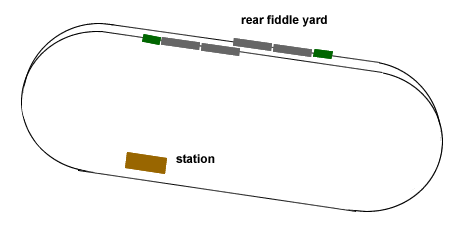
fitting lights and sound to an L&B
train
(or how we got chuffed by DCC
Supplies)
Bratton Fleming
will display as both a day and night scene,
so train and building lighting is necessary.
In addition, this time, we wished to include
discrete on board sound. This is when DCC
Supplies came to the rescue.
The Lynton and Barnstaple
Manning Wardles are the 'sausage dogs' of the
narrow gauge world. I have always loved them but
they are not to everybody's taste. When the
railway was scheduled to be closed, Captain Howey,
later of the Romney Hythe and Dymchurch fame,
visited the line with the thought of saving it. He
took one look at the 'ridiculous engines' and
walked away!
There are enough issues
just to fit the motor into the engine
along with a very small DCC chip (Digitrax DZ125).
The cab is not compromised in the new locomotives
being built for this layout and I suppose it
would have been possible to fit the sound chip
and speaker in there but it is nice to have full
cab detailing.
The side tanks cannot be used for electronics as
they have to be filled with lead in order to
obtain sufficient adhesion for the locos to haul
trains.
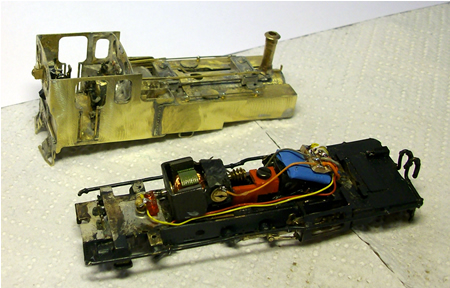
the anatomy of a sausage
dog
Locos are united
with 'companion cars' in order to enjoy more
available wheels, for current collection. The
obvious place to install sound is, of course, the
companion car.
Our trains only have one side ever visible. This has enabled us
to open up the doors in the guards compartment to
'let out the sound' of the installed speaker on
the blind side of the companion coach. The
open apertures were re-enforced by thin strips.
As the carriages are also
going to be lit, all holes in the floors have been
sealed off to prevent light leakage.
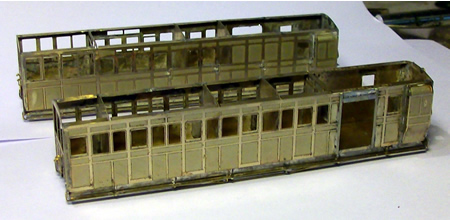 The two new brake cars with
guards doors opened up for sound The two new brake cars with
guards doors opened up for sound
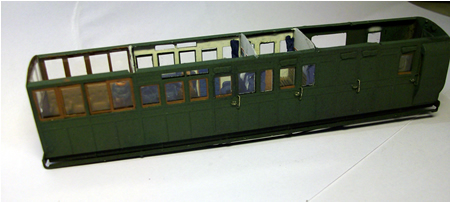 the first of the coaches
nearing completion the first of the coaches
nearing completion
Equipment
So
let us look at the general wiring requirement. One
pair of wires between stock of this small scale is
about all one can manage as the bending resistance
of any more will derail the stock on curves. As it
is, companion cars have to be quite heavily
ballasted to prevent this happening.
The main chip, a Digitrax
DZ125 remains in the loco. This will also operate
the loco light, using function 0. The companion
car also picks up track current and this is passed
through to the loco using thin flexible wire
supplied by DCC Supplies and micro
connectors from Express Models.
To
be able to switch on and off the carriage lights
and rear lamp on the coaches, an additional chip
is required. This is a Digitrax TL1 single
function chip. This is very low cost luckily.
Power for this is taken from the carriage track
power pickups. The chip is set to the same address
as the main chip and function 0 will be read, thus
switching on and off the carriage lights and rear
lamp when required. As delivered, the TL1 needs a
little programming. The loco address has to be
set for the required train, and to switch the
lights on and off with function 0, CV 61 has to
be set to 1.
The TL1
needs to be removable for programming as
the sound chip and the TL1 have some
programming incompatibility. I used
Express Models micro connectors to do
this.
Fitting instructions for
the TL1 can be found here. The capacitors have a
silver flash which is alongside the negative
contact. The
common wire should be connected to the positive
side of the capacitor.
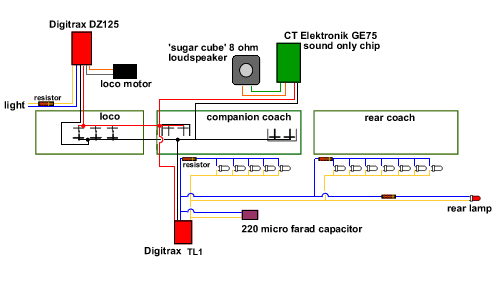 wiring schematic - click on
image to enlarge wiring schematic - click on
image to enlarge
loco
and carriage lamps
DCC Concepts in OZ produce
tiny working loco lamps. In the UK, they are
supplied by DCC Supplies but at over £31 for
six, they are definitely not cheap. We have found
the red lights seem to be very effective but we
have found the white lamps put out a rather blue
light. This can be 'tuned' but using a yellow
varnish over the optic. In addition, the lamps
are too small for L&B locos, so they must be
fitted inside the correct shaped lamp.
The wires of these lamps
are very fine indeed and require careful handling.
They are in fact so fine, that in many cases, they
need not be hidden.
The carriage lighting uses
warm white sub-miniature lighthouse LEDs, again
from DCC Supplies. These are soldered
to a couple of brass wire bus bars which are glued
onto the top of the coach cross partitions. Short
lengths of heat shrink sleeves are used to
insulate the brass bus bars from the metal
partitions. It is important to use the correct
resistors to ensure that the carriage light
intensity is correct. I have found that 6 to 9Kohm
resistors are ideal for us. If one coach has less
LEDs than another, it is necessary to add an
additional resistor so that the coach lighting
intensity is equal.
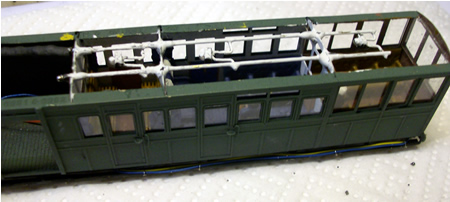 coach fitted with lighting coach fitted with lighting
 only some of the coach
lighting is installed at this point only some of the coach
lighting is installed at this point
Of
course, when wiring the connection from one coach
to the next, it is important that the polarity is
correct for the LEDs to operate.
DCC
Supplies
Once the donkey work had
been completed, it was time to trolley off to DCC Supplies; fortunately very
close by to us, just outside Worcester. The
company resides in what must be one of the most
pleasant business parks north of Watford. Nestling
amid pine trees, meadows, a recreational lake and
a small caravan park, husband and wife team Andy
and Fiona have recently moved into a most spacious
and well presented premises. The company is
quickly enlarging its stock of model makers
materials and is well worth a visit.
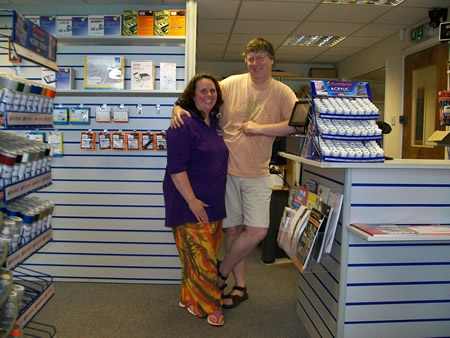 Andy and Fiona
DCC! Andy and Fiona
DCC!
Fiona tramples over all the
usual stereotypes of females and models
railways... she actually knows a lot about them
and is herself an expert on DCC operation. While
Andy got to work fitting the function chip, Fiona
programmed the sound chip.
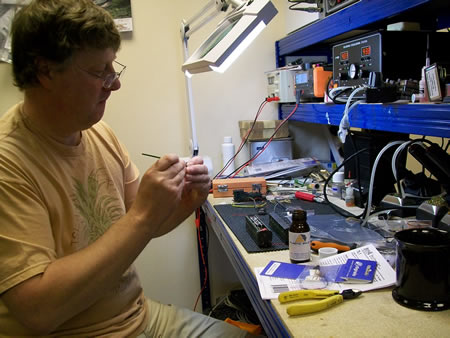
Working on 009 stock is
like being a keyhole surgeon. Andy always pulls
that face when working on my rolling stock!
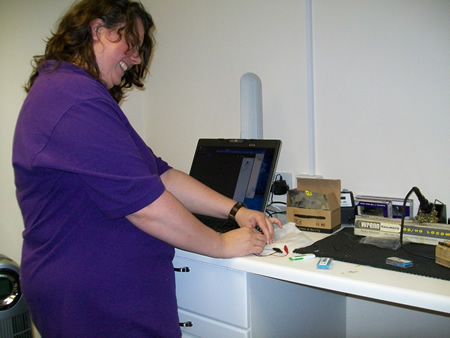 Fiona finally persuaded
the sound chip to be a steam engine rather than a
diesel! Fiona finally persuaded
the sound chip to be a steam engine rather than a
diesel!
It
was not long before everything was neatly
installed in the baggage car. I am amazed at how
small the loud speaker actually is. It belts out a
fair bit of volume too! Andy also installed a
capacitor between the two lighting wires which
stops flickering lights on bad bits of
track.
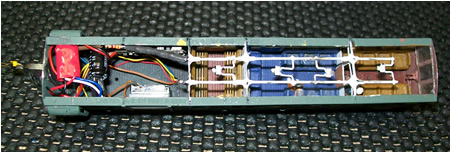 the completed
installation - click on image to
enlarge the completed
installation - click on image to
enlarge
After very little hassle,
the train was chuffing along the test track... see
the
video here.
There was still some
programming to do. This included assigning the
required sounds to the specified function numbers.
One will be a guards whistle which can be added to
the chip. The chuffs also need to be adjusted so
that there is the correct 2 per wheel
revolution. The sound of draincocks can be
added for starting and the occasional safety
valve blow off when stopped. Programming of the
chip, and even the loading of your custom sounds
is actually done through contact with the rails.
On
returning home, the train was quickly railed onto
County Gate where it happily chuffed around. Our
neighbours arrived quite quickly to watch and the
general consensus was that the effect is a rip
roaring success.
Following a second visit by Fiona of DCC
Supplies both trains have now been programmed to work correctly. Our own
choice of whistle sounds were loaded into the chip.
The number of chuffs per revolution was
adjusted as indeed was the volume.
To programme this chip, a fancy circuit
board is needed along with a good understanding of computers. There are
three volume levels for the main sound, (the chuff). In addition, other
sounds can be added to the chuff, such as braking, draincocks and pumps.
Additional sounds are actuated by function
switches.
There is no volume control for the function switch sounds so this has to
be adjusted before loading into the chip. The sounds have to be in mono.
Audacity is the perfect programme to do all of this.
It can take quite a few minutes to load the
sound to the chip and then the result has to be tested. It took the best
part of a day before we were happy with the results.
The result is convincing and excellent. It
is important to maintain the sound levels correct for viewing distance
and scale. Only too often, I see the sounds being played far too loud.
resistor calculator
I include this resource as it is so much
easier to choose the correct resistor with this method.
baseboard wiring
This layout has very simple wiring compared
with County Gate. There are only two operating turnouts, (the siding to
the goods shed is snow covered and will not work), and three blocks.


click on chosen baseboard for
wiring diagram

this is how the track layout looks like
on the Railroad & Co software

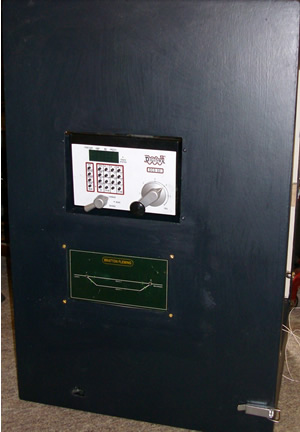
the wiring installation almost complete
- click on image to enlarge

click on image to enlarge
Lighting

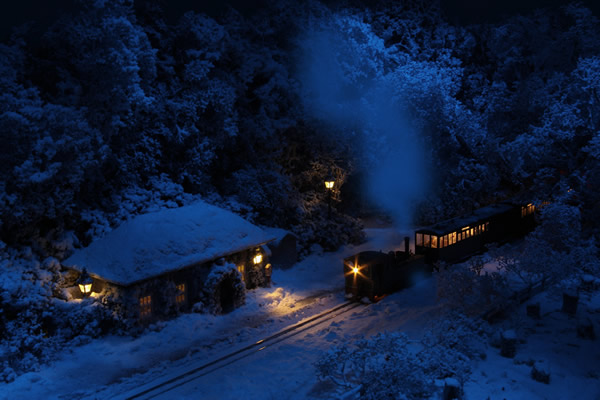
I have long
been impressed with how awful the light is
from low energy bulbs. They therefore seem
the obvious choice to illuminate Bratton
Fleming, which is being depicted on a dull
winter's day. I am using ten GU5 . 3 'blue
white' 12 volt LED spots. These put out a
harsh blue white light that perfectly lights
the snow and even makes you feel cold!. They are connected
to a dimmer so we can obtain nightfall when
required. The lights are set into holes cut
into the plywood and are lightly glued in
place with epoxy.
This is possible with LEDs because they run
cool but such a system would cause a fire
with halogen spots!
In addition, we
use an LED strip of blue white light which
we focus onto the backdrop to remove
shadows.
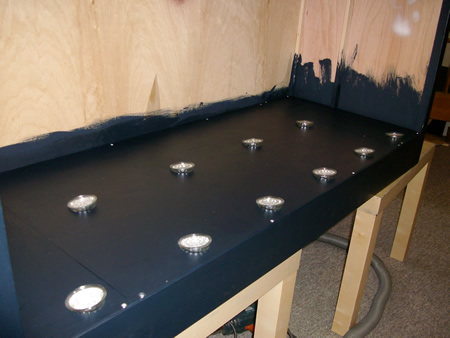
the baseboard inverted and the half the LEDs
already
installed -
click in image to enlarge
Another line of blue LEDs are installed
for night light. These are also
connected to a dimmer.

N95CC 220V
to 12DC 6amp (good for four GU5 LEDs)
size, approx 50mm X 35mm X 35mm
The
4 Maplin transformers are wired together in
parallel to produce sufficient power for the
lights. There
are two potential 12VDC feeds on each
transformer, each marked 0
and 12V. If you require the full output, the
12V tags must be joined together and
likewise for the 0 tags. The dimmers were
supplied by DCC Supplies.

|